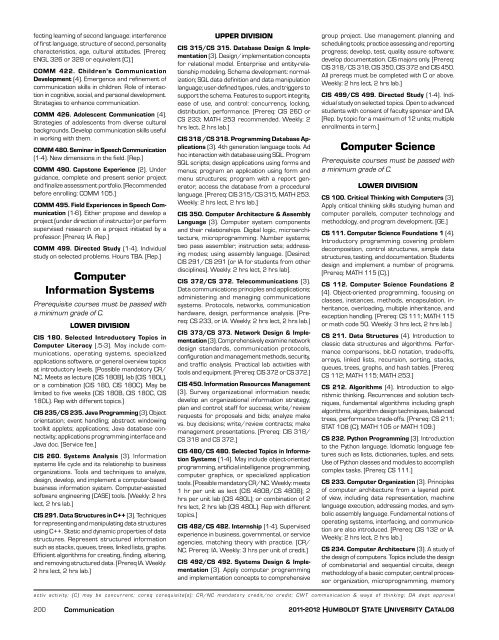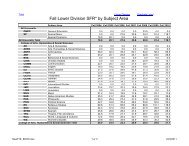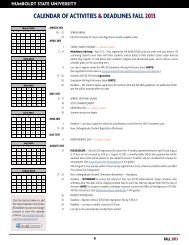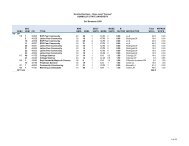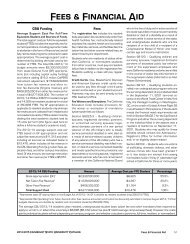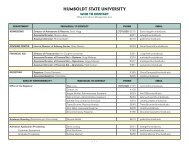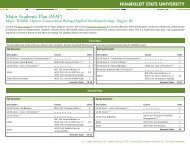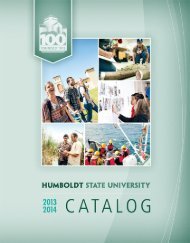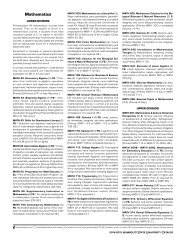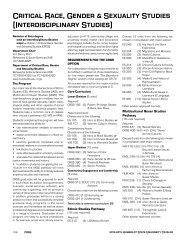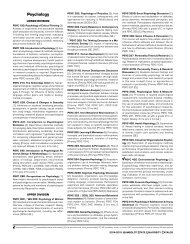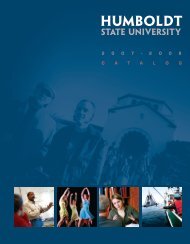2011-12 Academic Year - Bad Request - Humboldt State University
2011-12 Academic Year - Bad Request - Humboldt State University
2011-12 Academic Year - Bad Request - Humboldt State University
Create successful ePaper yourself
Turn your PDF publications into a flip-book with our unique Google optimized e-Paper software.
fecting learning of second language: interference<br />
of first language, structure of second, personality<br />
characteristics, age, cultural attitudes. [Prereq:<br />
ENGL 326 or 328 or equivalent (C).]<br />
COMM 422. Children’s Communication<br />
Develop ment (4). Emergence and refinement of<br />
com munication skills in children. Role of interaction<br />
in cognitive, social, and personal development.<br />
Strategies to enhance communication.<br />
COMM 426. Adolescent Communication (4).<br />
Strategies of adolescents from diverse cultural<br />
backgrounds. Develop communication skills useful<br />
in working with them.<br />
COMM 480. Seminar in Speech Communication<br />
(1-4). New dimensions in the field. [Rep.]<br />
COMM 490. Capstone Experience (2). Under<br />
guidance, complete and present senior project<br />
and finalize assessment portfolio. [Recommended<br />
before enrolling: COMM 105.]<br />
COMM 495. Field Experiences in Speech Communication<br />
(1-6). Either propose and develop a<br />
project (under direction of instructor) or perform<br />
supervised research on a project initiated by a<br />
professor. [Prereq: IA. Rep.]<br />
COMM 499. Directed Study (1-4). Individual<br />
study on selected problems. Hours TBA. [Rep.]<br />
Computer<br />
Information Systems<br />
Prerequisite courses must be passed with<br />
a minimum grade of C.<br />
LOWER DIVISION<br />
CIS 180. Selected Introductory Topics in<br />
Computer Literacy (.5-3). May include communications,<br />
operating systems, specialized<br />
applications software, or general overview topics<br />
at introductory levels. [Possible mandatory CR/<br />
NC. Meets as lecture (CIS 180B), lab (CIS 180L),<br />
or a combination (CIS 180, CIS 180C). May be<br />
limited to five weeks (CIS 180B, CIS 180C, CIS<br />
180L). Rep with different topics.]<br />
CIS 235/CS 235. Java Programming (3). Object<br />
orientation; event handling; abstract windowing<br />
toolkit applets; applications; Java database connectivity;<br />
applications programming interface and<br />
Java doc. [Service fee.]<br />
CIS 260. Systems Analysis (3). Information<br />
systems life cycle and its relationship to business<br />
organizations. Tools and techniques to analyze,<br />
design, develop, and implement a computer-based<br />
business information system. Computer-assisted<br />
software engineering (CASE) tools. [Weekly: 2 hrs<br />
lect, 2 hrs lab.]<br />
CIS 291. Data Structures in C++ (3). Techniques<br />
for representing and manipulating data structures<br />
using C++. Static and dynamic properties of data<br />
structures. Represent structured information<br />
such as stacks, queues, trees, linked lists, graphs.<br />
Efficient algorithms for creating, finding, altering,<br />
and removing structured data. [Prereq IA. Weekly:<br />
2 hrs lect, 2 hrs lab.]<br />
UPPER DIVISION<br />
CIS 315/CS 315. Database Design & Implementation<br />
(3). Design/implementation concepts<br />
for relational model. Enterprise and entity-relationship<br />
modeling. Schema development: normalization;<br />
SQL data definition and data manipulation<br />
language; user-defined types, rules, and triggers to<br />
support the schema. Features to support integrity,<br />
ease of use, and control: concurrency, locking,<br />
distribution, performance. [Prereq: CIS 260 or<br />
CS 233; MATH 253 recommended. Weekly: 2<br />
hrs lect, 2 hrs lab.]<br />
CIS 318 /CS 318. Programming Database Applications<br />
(3). 4th generation language tools. Ad<br />
hoc interaction with database using SQL. Pro gram<br />
SQL scripts; design applications using forms and<br />
menus; program an application using form and<br />
menu structures; program with a report generator;<br />
access the database from a procedural<br />
language. [Prereq: CIS 315/CS 315, MATH 253.<br />
Weekly: 2 hrs lect, 2 hrs lab.]<br />
CIS 350. Computer Architecture & Assembly<br />
Language (3). Computer system components<br />
and their relationships. Digital logic, microarchitecture,<br />
microprogramming. Number systems;<br />
two pass assembler; instruction sets; addressing<br />
modes; using assembly language. [Desired:<br />
CIS 291/CS 291 (or IA for students from other<br />
disciplines). Weekly: 2 hrs lect, 2 hrs lab].<br />
CIS 372/CS 372. Telecommunications (3).<br />
Data communications principles and applications;<br />
administering and managing communications<br />
systems. Protocols, networks, communication<br />
hardware, design, performance analysis. [Prereq:<br />
CS 233, or IA. Weekly: 2 hrs lect, 2 hrs lab.]<br />
CIS 373/CS 373. Network Design & Implementation<br />
(3). Comprehensively examine network<br />
design standards, communication protocols,<br />
configuration and management methods, security,<br />
and traffic analysis. Practical lab activities with<br />
tools and equipment. [Prereq: CIS 372 or CS 372.]<br />
CIS 450. Information Resources Management<br />
(3). Survey organizational information needs;<br />
de velop an organizational in formation strategy;<br />
plan and control; staff for success; write/review<br />
requests for proposals and bids; analyze make<br />
vs. buy decisions; write/review contracts; make<br />
management presentations. [Prereq: CIS 318/<br />
CS 318 and CS 372.]<br />
CIS 480/CS 480. Selected Topics in Information<br />
Systems (1-4). May include object-oriented<br />
programming, artificial intelligence programming,<br />
computer graphics, or specialized application<br />
tools. [Possible mandatory CR/NC. Weekly: meets<br />
1 hr per unit as lect (CIS 480B/CS 480B); 2<br />
hrs per unit lab (CIS 480L); or combination of 2<br />
hrs lect, 2 hrs lab (CIS 480L). Rep with different<br />
topics.]<br />
CIS 482/CS 482. Internship (1-4). Supervised<br />
experience in business, governmental, or service<br />
agencies, matching theory with practice. [CR/<br />
NC. Prereq: IA. Weekly: 3 hrs per unit of credit.]<br />
CIS 492/CS 492. Systems Design & Implementation<br />
(3). Apply computer programming<br />
and implementation concepts to comprehen sive<br />
group project. Use management planning and<br />
scheduling tools; practice assessing and reporting<br />
progress; develop, test, quality assure software;<br />
develop documentation. CIS majors only. [Prereq:<br />
CIS 318/CS 318, CIS 350, CIS 372 and CIS 450.<br />
All prereqs must be completed with C or above.<br />
Weekly: 2 hrs lect, 2 hrs lab.]<br />
CIS 499/CS 499. Directed Study (1-4). Individual<br />
study on selected topics. Open to advanced<br />
students with consent of faculty sponsor and DA.<br />
[Rep. by topic for a maximum of <strong>12</strong> units; multiple<br />
enrollments in term.]<br />
Computer Science<br />
Prerequisite courses must be passed with<br />
a minimum grade of C.<br />
LOWER DIVISION<br />
CS 100. Critical Thinking with Computers (3).<br />
Apply critical thinking skills studying human and<br />
computer parallels, computer technology and<br />
methodology, and program development. [GE.]<br />
CS 111. Computer Science Foundations 1 (4).<br />
Introductory programming covering problem<br />
decomposition, control structures, simple data<br />
structures, testing, and documentation. Students<br />
design and implement a number of programs.<br />
[Prereq: MATH 115 (C).]<br />
CS 1<strong>12</strong>. Computer Science Foundations 2<br />
(4). Object-oriented programming, focusing on<br />
classes, instances, methods, encapsulation, inheritance,<br />
overloading, multiple inheritance, and<br />
exception handling. [Prereq: CS 111; MATH 115<br />
or math code 50. Weekly: 3 hrs lect, 2 hrs lab.]<br />
CS 211. Data Structures (4). Introduction to<br />
classic data structures and algorithms. Performance<br />
comparisons, bit-O notation, trade-offs,<br />
arrays, linked lists, recursion, sorting, stacks,<br />
queues, trees, graphs, and hash tables. [Prereq:<br />
CS 1<strong>12</strong>; MATH 115; MATH 253.]<br />
CS 2<strong>12</strong>. Algorithms (4). Introduction to algorithmic<br />
thinking. Recurrences and solution techniques,<br />
fundamental algorithms including graph<br />
algorithms, algorithm design techniques, balanced<br />
trees, performance trade-offs. [Prereq: CS 211;<br />
STAT 108 (C); MATH 105 or MATH 109.]<br />
CS 232. Python Programming (3). Introduction<br />
to the Python language. Idiomatic language features<br />
such as lists, dictionaries, tuples, and sets.<br />
Use of Python classes and modules to accomplish<br />
complex tasks. [Prereq: CS 111.]<br />
CS 233. Computer Organization (3). Principles<br />
of computer architecture from a layered point<br />
of view, including data representation, machine<br />
language execution, addressing modes, and symbolic<br />
assembly language. Fundamental notions of<br />
operating systems, interfacing, and communication<br />
are also introduced. [Prereq: CIS 132 or IA.<br />
Weekly: 2 hrs lect, 2 hrs lab.]<br />
CS 234. Computer Architecture (3). A study of<br />
the design of computers. Topics include the design<br />
of combinatorial and sequential circuits, design<br />
methodology of a basic computer, central processor<br />
organization, microprogramming, memory<br />
activ activity; (C) may be concurrent; coreq corequisite(s); CR/NC mandatory credit/no credit; CWT communication & ways of thinking; DA dept approval<br />
200 Communication<br />
<strong>2011</strong>-20<strong>12</strong> <strong>Humboldt</strong> <strong>State</strong> <strong>University</strong> Catalog


